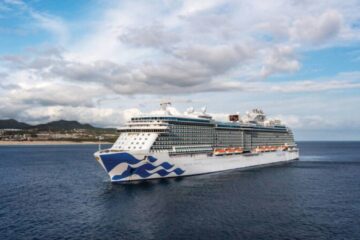The two cruise lines are constantly trying to one-up each other and Royal Caribbean may have just gained a major advantage.
Sending a email while on a cruise can be a challenge and streaming video or texting photos is sometimes simply impossible. That’s because cruise ship internet has pretty major limitations.
To put it bluntly, cruise internet is slow. Passengers pay around $20 per day for access on one device (which you can move between devices) and the service can be very iffy. On sea days, when a lot of people onboard use their phones to access the internet, outages are common and connection speeds slow to a crawl.
Both Carnival Cruise Lines (CCL) – Get Carnival Corporation Report and Royal Caribbean International (RCL) – Get Royal Caribbean Group Report have this problem, although speeds can vary based on weather and the age of the equipment on the ship. Experiences can also vary based on how many passengers are on board and how many of them have purchased internet packages.
Royal Caribbean bills its Voom internet service as “the fastest internet at sea.” That’s true, but it’s also relative because internet at sea generally performs like a dial-up connection in 1994. The cruise line describes its higher end “Surf and Stream” package as follows.
“The VOOM Surf + Stream Voyage Package lets you message and video chat on messenger services, browse the web, send emails and post on social media, and video chat live. Plus stream your favorite videos, movies, music and shows,” the company shares on it website.
And, sure, it can do all those things under optimal conditions (clear sky, limited amount of people onboard using the service) but even Voom is very slow compared to land-based services. The good news for Royal Caribbean passengers is that the cruise line appears to have a solution that will solve that problem.
Image source: Daniel Kline.
Elon Musk’s Starlink Testing on Freedom of the Seas
Royal Caribbean quietly installed Starlink satellite internet receivers on Freedom of the Seas earlier in June. At the same time, the cruise line petitioned the Federal Communications Commission (FCC) to allow it to use the service on cruise ships as Starlink, a company created by Elon Musk, can currently not be used on anything that moves.
“We write today to respectfully request that you act expeditiously and look favorably upon the pending application filed by SpaceX Services, Inc. and referenced above,” the cruise line wrote.
The letter made it clear that Royal Caribbean has high hopes for the service.
“We believe our work with SpaceX, the first of its kind in the cruise industry will set the standard for other cruise operators and will mean a leap in terms of guest experience and business operations while at sea.”
The FCC has not publicly answered but the cruise line has moved forward with offering Starlink internet on Freedom of the Seas. It has not commented on doing this publicly, but multiple people have shared pictures of the satellite receivers on the ship, and the Royal Caribbean Blog recently shared one passengers experience using the new service.
How Does Starlink Work on Freedom of the Seas?
Nicole Feist wrote an article for Royal Caribbean Blog, which has no affiliation with the cruise line, about her experience using Starlink on Freedom of the Seas. It’s important to note that Royal Caribbean has not promoted Starlink as an option nor has it promised that passengers will have access to the service.
On her sailing, Feist and her husband purchased both a Surf & Stream package as well as the lower-end Surf package. Their experience was very positive and performed much better than their previous experiences with Voom.
“The Surf package showed a download speed of 9.01 Mbps and upload speed of 20.34 Mbps. The Surf & Stream gave a download speed of 77.03 Mbps and upload speed of 15.72 Mbps,” she wrote. “On both devices, we tried watching YouTube videos and Netflix shows to see how they would work. Both packages allowed us to instantly start watching the videos, with no lag or buffering time.”
On a normal cruise — even one of the newer ships — it’s generally difficult, if not impossible to stream without lag (or sometimes at all). The quality of their connection did vary based one where they were on the ship (their interior room was the slowest) but it was still magnitudes better than the speeds previously offered and it appeared to be adequate for things like video calls as well as streaming video.
Royal Caribbean has not commented on its plans to expand Starlink across the fleet or even to formally offer it on Freedom of the Seas. That decision is likely dependent on the FCC granting approval.
Carnival has not tried a similar test.


